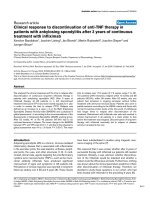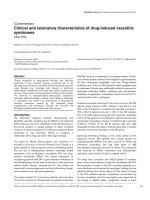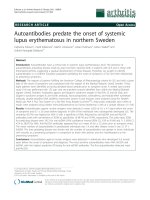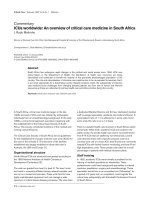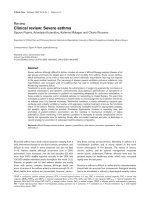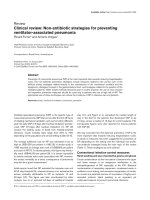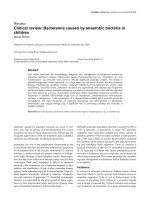Báo cáo y học: "Clinical review: Specific aspects of acute renal failure in cancer patients" pot
Bạn đang xem bản rút gọn của tài liệu. Xem và tải ngay bản đầy đủ của tài liệu tại đây (66.92 KB, 7 trang )
Page 1 of 7
(page number not for citation purposes)
Available online />Abstract
Acute renal failure (ARF) in cancer patients is a dreadful
complication that causes substantial morbidity and mortality.
Moreover, ARF may preclude optimal cancer treatment by requiring
a decrease in chemotherapy dosage or by contraindicating
potentially curative treatment. The pathways leading to ARF in
cancer patients are common to the development of ARF in other
conditions. However, ARF may also develop due to etiologies
arising from cancer treatment, such as nephrotoxic chemotherapy
agents or the disease itself, including post-renal obstruction,
compression or infiltration, and metabolic or immunological
mechanisms. This article reviews specific renal disease in cancer
patients, providing a comprehensive overview of the causes of ARF
in this setting, such as treatment toxicity, acute renal failure in the
setting of myeloma or bone marrow transplantation.
Introduction
Acute renal failure (ARF) is a serious complication of
malignancies that causes substantial morbidity and mortality.
Among critically ill cancer patients (CICPs), 12% to 49%
experience ARF and 9% to 32% require renal replacement
therapy during their intensive care unit (ICU) stay [1-5]. The
risk for ARF seems higher in CICPs than in other critically ill
patients [2,6]. In critically ill patients with cancer, acute renal
dysfunction usually occurs in the context of multiple organ
dysfunctions and is associated with mortality rates ranging
from 72% to 85% when renal replacement therapy is needed
[1,2]. Moreover, the recent report of Benoit and colleagues
[2] suggest that cancer patients admitted with acute kidney
injury requiring renal replacement therapy may have a better
prognosis if bacterial infection is present at admission. Lastly,
prognosis for this population seems to be worse than the
prognosis for a control cohort of critically ill patients without
malignancy receiving renal replacement therapy [2]. In
addition to hospital mortality, development of an ARF may
preclude optimal cancer treatment by requiring a decrease in
chemotherapy dosage or by contraindicating potentially
curative treatment (e.g., high-dose methotrexate in patients
with recently diagnosed Burkitt lymphoma) [7].
Unresolved issues in this setting are similar to those in the
overall population of patients with ARF, namely, the definition
of ARF, the possible benefits from early dialysis, and the
optimal dialysis dose.
Multiple causes leading to ARF in critically ill cancer patients
are often present in combination (listed in Table 1). Although
some of these causes are common to the general ICU
population (sepsis, shock, aminoglycosides), some are
related to the malignancy itself or to its treatment. Moreover,
in several studies, critically ill cancer patients have been
admitted with a newly diagnosed malignancy and are
therefore at risk to develop such type of malignancy-related
acute kidney injury [5,8,9]. A better knowledge of organ
failure related to malignant disease may potentially lead to an
improvement in these patients’ outcomes.
The objective of this review is to describe specific aspects of
renal disease in CICPs, to provide a comprehensive overview
of the causes of ARF in this population, and to describe
recent progress in the management of these complications,
including treatment toxicity and bone marrow transplantation
(BMT). Because prevention of ARF is mandatory, possible
measures for its treatment in CICPs are also discussed.
Methods: search strategy
Combinations of key words related to acute kidney injury
(e.g., acute renal failure, dialysis, hemofiltration, ICU) and
cancer (e.g., cancer, malignancy, chemotherapy, BMT) were
used to search the MEDLINE database and the Cochrane
Group database. The last search was performed in February
2006. We checked the bibliographies of retrieved reports
and reviews. We carefully checked the reviews and articles,
Review
Clinical review: Specific aspects of acute renal failure in cancer
patients
Michael Darmon, Magali Ciroldi, Guillaume Thiery, Benoît Schlemmer and Elie Azoulay
Assistance Publique des Hôpitaux de Paris, Saint-Louis University Hospital, Medical ICU, Paris, France
Corresponding author: Michael Darmon,
Published: 11 April 2006 Critical Care 2006, 10:211 (doi:10.1186/cc4907)
This article is online at />© 2006 BioMed Central Ltd
ARF = acute renal failure; BMT = bone marrow transplantation; CICP = critically ill cancer patient; ICU = intensive care unit; SOS = Sinusoidal
obstruction syndrome; TLS = tumour lysis syndrome; TMA = thrombotic microangiopathy.
Page 2 of 7
(page number not for citation purposes)
Critical Care Vol 10 No 2 Darmon et al.
focusing on acute kidney failure in the general ICU
population. The most relevant articles were selected by the
authors (MC, MD and EA) to give a concise and up-to-date
overview of this problem.
Acute renal failure related to intra-renal or
extra-renal obstruction
Acute tumor lysis syndrome
Tumour lysis syndrome (TLS) is a potentially life-threatening
complication of cancer treatment in patients with extensive,
rapidly growing, chemosensitive malignancies. TLS results
from the rapid destruction of malignant cells, which abruptly
release intracellular ions, proteins and metabolites into the
extra-cellular space. ARF may develop, the most common
mechanism being uric acid crystal formation in the renal
tubules secondary to hyperuricaemia. Another cause may be
calcium phosphate deposition related to hyperphosphataemia.
TLS may occur spontaneously before treatment, but it usually
develops shortly after the initiation of cytotoxic chemotherapy
[10]. Although this syndrome typically occurs in patients with
high-grade haematological malignancies, there have been
anecdotal reports of TLS in a variety of other haematological
malignancies, including low-grade non-Hodgkin’s lymphoma
and Hodgkin’s disease, and it has also been reported in
patients with fast-growing solid tumours, such as testicular
cancer [11,12].
Early recognition of patients at high risk for acute TLS may
allow the initiation of prophylactic measures. The clinical
presentation, risk factors and prophylactic measures are
described in Table 2. Non-recombinant urate oxidase
(Uricozyme
®
) and, more recently, recombinant urate oxidase
(Rasburicase
®
) have been shown to reduce uric acid levels,
thereby diminishing the risk of uric acid deposition
nephropathy [13]. Urine alkalisation, which was previously
recommended to prevent uric acid precipitation within the
renal tubules, has become controversial, since urate oxidase
therapy considerably reduces the risk of uric acid
precipitation, and urine alkalisation may induce calcium
phosphate deposition [14].
Calcium phosphate crystal deposition has been reported to
occur when the [calcium] × [phosphates] molar product
exceed 4.6 [15]. Nevertheless, this study has a number of
methodological weaknesses [15]. Therefore, we believe that
renal replacement therapy should be started on an
emergency basis when hydration fails to produce a prompt
metabolic improvement or when ARF develops. Phosphate
clearance is higher with sequential dialysis than with
haemofiltration, but is frequently associated with a rebound
effect after dialysis [16]. Therefore, we often use either
repeated sequential haemodialysis or isolated sequential
dialysis followed by continuous haemofiltration.
Table 1
Causes of acute renal failure in cancer patients
Pre-renal failure Sepsis
Extracellular dehydration (diarrhoea, mucitis, vomiting)
Sinusoidal obstruction syndrome (formerly called hepatic veno-occlusive disease)
Drugs (e.g., calcineurin inhibitors, ACE inhibitors, NSAIDs)
Capillary-leak syndrome (IL2)
Intrinsic failure
Acute tubular necrosis Ischaemia (shock, severe sepsis)
Nephrotoxic agents (contrast agents, aminoglycosides, amphotericin, ifosfamide, cisplatin)
Disseminated intravascular coagulation
Intravascular haemolysis
Acute interstitial nephritis Immuno-allergic nephritis
Pyelonephritis
Cancer infiltration (e.g., lymphoma, metastasis)
Nephrocalcinosis
Vascular nephritis Thrombotic microangiopathy
Vascular obstruction
Glomerulonephritis Amyloidosis (AL, myeloma; AA, renal carcinoma or Hodgkin’s disease)
Immunotactoid glomerulopathy
Membranous glomerulonephritis (pulmonary, breast or gastric carcinoma)
IgA glomerulonephritis, focal glomerulosclerosis
Post-renal failure Intra-renal obstruction (e.g., urate crystals, light chain, acyclovir, methotrexate)
Extrarenal obstruction (retroperitonal fibrosis, ureteral or bladder outlet obstruction)
ACE inhibitors, angiotensin-converting enzyme inhibitors; NSAIDs, non-steroidal anti-inflammatory drugs.
Page 3 of 7
(page number not for citation purposes)
Cast nephropathy
Up to 50% of patients with newly diagnosed multiple
myeloma have renal failure and up to 10% require dialysis
[17]; renal failure is reversible in half of these patients (most
of them having cast nephropathy) [18,19]. Several factors
may cause renal failure in myeloma patients, with cast
nephropathy the most common cause. The clinical
presentation of cast nephropathy usually combines ARF and
Bence-Jones proteinuria. Numerous casts are present in the
renal tubules, which are formed when light chains bind to a
specific peptide domain on the Tamm-Horsfall protein [17];
variations in CDR3 in both the κ and λ light chains influence
binding [20]. Additionally, hypovolaemia, sepsis, urinary pH
< 7, or hypercalciuria may promote cast formation. The
prevention and treatment of renal failure rests on fluid
infusion, elimination of nephrotoxic compounds, urine
alkalisation in patients with Bence-Jones proteinuria, and
correction of hypercalcemia. Since it may transiently remove
light chains, plasma exchange has been supposed to be
beneficial in treating some patients with ARF. A recent large
randomised study, however, found no conclusive evidence
that five to seven plasma exchanges substantially reduce the
death rate or dialysis dependence at 6 months [21].
Although renal failure has been considered to indicate a poor
prognosis, several studies demonstrate that long-term
survival can be achieved. Therefore, prompt evaluation of
these patients for autologous stem cell transplantation should
be performed, and dependency on dialysis is no longer
considered a contraindication to autologous BMT [22,23].
Extra-renal obstruction
ARF can result from obstruction located within the kidneys
(crystals and proteins) or downstream of the kidneys. The
clinical manifestations vary with the site, degree, and rapidity
of obstruction. Urinary findings are classically non-diagnostic,
and renal ultrasonography remains the method of choice for
investigating extra-renal obstruction. Obstructive uropathy
may nevertheless be present without hydronephrosis, during
the first few days, when the collecting system is encased in
retroperitoneal fibrosis or tumour or when the obstruction is
partial [24]. The relief of the obstruction, either by
percutaneous nephrostomy or through a ureteral stent, is the
cornerstone of treatment. Renal recovery depends on the
severity and duration of the obstruction [24].
Thrombotic microangiopathy
The association between thrombotic microangiopathy (TMA)
and cancer was first described in 1973 and is now well
established. TMA may be associated with the cancer itself,
with cancer chemotherapy, or with allogeneic BMT [25].
Thrombocytopenia with microangiopathic haemolytic anaemia
(peripheral non-autoimmune anaemia with schizocytes) and
no alternative diagnosis is considered sufficient to establish a
presumptive diagnosis of TMA. In this setting, disseminated
intravascular coagulopathy must be ruled out. The incidence
of TMA associated with cancer is difficult to estimate
because of possible confusion with disseminated
intravascular coagulopathy; it may be as high as 5% [26].
Most of the cases occur in patients with solid tumours, the
most common type being adenocarcinoma (stomach, breast
and lung) [26]; however, TMA has been reported in patients
with other solid tumours or haematological malignancies [25].
The pathophysiology of the TMA-malignancy association
remains controversial, although many studies suggest an
insult to the vascular endothelium. Nevertheless, recent
studies have shown that disseminated cancer was
associated with decreased ADAMTS13 activity, without anti-
ADMTS13 antibody [27].
The link between TMA and cancer chemotherapy was first
described with mitomycin C. Subsequently, TMA has been
Available online />Table 2
Acute tumour lysis syndrome: associated malignancies, risk
factors, clinical presentation and prophylactic treatment
Malignancies associated with TLS
High risk High-grade non-Hodgkin’s lymphoma
Acute lymphoid leukaemia
Acute myeloid leukaemia
Intermediate risk Myeloma
Low-grade non-Hodgkin’s lymphoma
Small-cell lung carcinoma
Low risk Medulloblastoma
Breast or gastrointestinal carcinoma
Risk factors Tumour spread
Rapid tumour growth
Chemosensitive tumour
LDH >1,500 IU/l
Hypokalaemia/hypophosphataemia
Pre-existing renal failure
Clinical presentation
Hyperkalaemia Intracellular potassium release
Hyperphosphataemia Intracellular PO
4
–
release
Calcium phosphate deposition
Hypocalcaemia Calcium phosphate deposition
Rarely symptomatic
Hyperuricaemia Nucleic acid degradation
Acute renal failure
Prevention Volume expansion
Urate oxidase if risk factor for TLS
Urine alkalisation controversial
Do not correct hypocalcaemia if
asymptomatic
If [calcium] × [phosphate] remains above
4.6 despite prophylactic measures,
initiate renal replacement therapy
Avoid correction of hypokalaemia or
hypophosphoraemia before induction
LDH, lactate dehydrogenase; TLS, tumour lysis syndrome.
reported with many anti-cancer agents, including gemcita-
bine, bleomycin, cisplatin, CCNU, cytosine arabinoside,
daunorubicin, deoxycoformycin, 5-FU, azathioprine and
interferon α [25].
Lastly, the association between TMA and BMT has been
known since 1980. Although the prognosis has been
described as poor, the clinical presentation is heterogeneous,
with some patients having renal failure as the only
manifestation and others experiencing remissions [28].
Typically, TMA starts 2 to 12 months after BMT and is
unresponsive to plasma therapy [29]. Total body irradiation
and graft-versus-host disease are the main factors associated
with TMA in BMT recipients. Therefore, radiation nephritis
may be a contributor, although cases of TMA related to
cytomegalovirus infection have been reported [28,30].
The optimal treatment for this highly specific subtype of TMA
is unknown. Plasma exchanges have been shown to improve
prognosis in the general population of patients with TMA
[31]. More recently, a study focusing on patients admitted
into the ICU with severe TMA reported similar results [32].
Both these studies excluded patients with cancer related
TMA, however, and the study of Penne and colleagues [32]
excluded patients with TMA after BMT. Moreover,
plasmatherapy is known to be rarely effective in this setting
[29,33]. The recent guidelines of the British Society of
Haematology did not recommend plasmatherapy in cancer-
related TMA or in TMA after BMT [33]. Effective treatment for
this group of patients is, however, lacking. Protein-A column
immunoabsorption has been proposed as a possible
treatment, without strong evidence of its effectiveness (the
grade of recommendation by the British Society of
Haematology is C) [33]. Causative factors should be looked
for and antihypertensive treatment given. Lastly, in the
absence of guidelines, we believe that plasma exchange
should be proposed in patients with severe cancer treatment-
associated TMA.
Renal toxicity related to cancer therapy
Renal toxicity of cancer chemotherapy
We will focus on nephrotoxic anticancer agents and on avenues
for kidney protection. Three drugs are commonly associated
with ARF, namely, cisplatin, ifosfamide and methotrexate.
Cisplatin-induced renal toxicity
Cisplatin is probably the most extensively studied nephrotoxic
anticancer agent. Although direct tubular toxicity may cause
ARF, cisplatin has also been associated with chronic dose-
dependent reduction of the glomerular filtration rate [34]. The
most widely used protective measure is saline infusion to
induce solute diuresis. Cisplatin is usually administered in
divided doses for 5 days. The maximum dose should not
exceed 120 mg/m
2
body surface area, and renal dysfunction
may require a dosage reduction. Repeated administration up
to a cumulative dose of 850 mg was associated with a 9%
reduction in glomerular filtration rate over a 5 year period,
compared to a 40% reduction in patients given more than
850 mg [34]. Amifostine (inorganic thiophosphates) has been
found to be effective in preventing renal failure, even after
repeated exposure. Therefore, the American Society of Clinical
Oncology stated that amifostine (910 mg/m
2
) may be
considered for the prevention of nephrotoxicity in patients
receiving cisplatin-based chemotherapy (grade of recommen-
dation A) [35]. Stevens-Johnson syndrome and toxic epidermic
necrolysis have been reported in patients given amifostine.
Methotrexate
Methotrexate is widely used to treat cancer. High-dose
methotrexate (> 1 g/m
2
) is part of the treatment of acute
lymphoid leukaemia, high-grade lymphoma and sarcoma.
These high doses are associated with a high risk of ARF due
to precipitation of methotrexate or its metabolite, 7-OH-
methotrexate, within the renal tubules. When ARF occurs, the
resulting decrease in methotrexate clearance leads to extra-
renal toxicity (neutropenia, hepatitis, orointestinal mucositis
and/or neurological impairment). Thus, methotrexate toxicity
may manifest as multiple organ failure [24].
Prevention of nephrotoxicity, together with methotrexate level
monitoring, is crucial to prevent extrarenal methotrexate
toxicity. During methotrexate infusion and elimination, fluids
should be given to maintain a high urinary output and urinary
alkalisation should be performed to keep the urinary pH
above 7.5. Rescue with folinic acid (50 mg four times a day)
should be started 24 hours after each high-dose metho-
trexate infusion and serum methotrexate concentrations
should be measured every day. Patients are considered at
high risk for methotrexate toxicity when serum levels are
greater than 15 µM/l at 24 h, 1.5 µM/l at 48 h, or 0.5 µM/l at
72 h. Unless absolutely necessary, patients should not be
given medications that inhibit folate metabolism (e.g.,
trimethoprim-sulfamethoxazole), exhibit intrinsic renal toxicity
(e.g., non-steroidal anti-inflammatory agents and contrast
agents), or decrease the fraction of methotrexate bound to
albumin (e.g., aspirin). When all these measures were taken,
the incidence of ARF was 1.8% in patients with sarcoma [36].
In patients with ARF, methotrexate removal by renal replace-
ment therapy (peritoneal dialysis, haemodialysis, haemofiltration
or haemoperfusion) has been used, with disappointing results.
Although haemodialysis may achieve a 52% reduction in
plasma methotrexate concentrations, post-dialysis rebound
has been described [36]. Carboxypeptidase-G
2
is a bacterial
enzyme that converts methotrexate into an inactive metabolite
(2,4-diamino-N10-methylpteroic acid), thus providing an
alternative route of elimination. Its use lowered plasma
methotrexate concentrations to non-toxic levels (by 98% in
15 minutes), although rebounds (with an increase no greater
than 10% in plasma methotrexate concentrations) occurred
in 60% of patients [37]. Carboxypeptidase-G
2
and high-dose
leucovorin have been tested in patients with methotrexate
Critical Care Vol 10 No 2 Darmon et al.
Page 4 of 7
(page number not for citation purposes)
intoxication and ARF, with similar results [38]. Therefore, no
recommendations can be made concerning renal
replacement therapy or carboxypeptidase-G
2
in this population.
Alkylating agents
The main anticancer agents responsible for haemorrhagic
cystitis are alkylating agents, such as cyclophosphamide and
ifosfamide. Maintaining a high urinary output and con-
comitantly administering the bladder epithelium protectant
mesna virtually eliminated haemorrhagic cystitis related to the
toxicity of anticancer agents [35,39]. However, several other
toxic effects of these drugs have been described, including
emesis, alopecia, myelosuppression and neurotoxicity.
Moreover, ifosfamide has been associated with ARF or acute
tubular dysfunction [40]. In a paediatric study, up to 22% of
patients experienced either ARF or Fanconi syndrome [40].
Acute renal failure in allogenic hematopoietic
progenitor cell recipients
ARF is among the most common potentially life-threatening
complications in BMT recipients. Occurrence rates of 30% to
84% have been reported [30,41]. Sinusoidal obstruction
syndrome (SOS; previously known as veno-occlusive disease
of the liver) is the main cause of ARF in this setting [41]. This
may explain why the incidence of ARF remains higher in
allogeneic than in autologous BMT recipients [42,43]. A
retrospective review showed that SOS was present in 90%
of patients who experienced ARF in the early post-BMT
period [41]. Nevertheless, BMT recipients are exposed to
multiple risk factors for acute renal dysfunction, including
toxicity from medications (e.g., amphotericin and amino-
glycoside) and contrast agents, sepsis, and extracellular
dehydration. These risk factors may increase the incidence or
precipitate the development of ARF associated with a
specific disease [44]. The prognosis of ARF remains
ominous, with a reported mortality rate as high as 85% in
patients requiring renal replacement therapy [41]. This grim
prognosis seems related in large part to the association
between ARF and severe SOS [30,44].
Marrow infusion toxicity (haemoglobinuria)
Overt haemoglobinuria due to marrow infusion develops in
75% to 100% of patients who receive cryopreserved marrow
infusions [45,46]. Cryopreservation of harvested bone
marrow is associated with erythrocyte disruption and requires
the addition of dimethyl sulfoxide (DMSO), of which high
concentrations may cause in vivo haemolysis during infusion
[44]; however, haemoglobinuria due to marrow infusion rarely
leads to ARF [44]. Although a classic complication,
haemoglobinuria has become rare since the introduction of
routine prophylactic volume expansion and improvements in
cryopreservation and marrow infusion modalities [44].
Sinusoidal obstruction syndrome
Liver damage is a common complication of cytoreductive
therapy and develops in 20% to 40% of BMT recipients [47].
The main site of liver damage in this setting is the hepatic
sinusoid, and the resulting clinical syndrome is called SOS.
Numerous risk factors for SOS have been identified
(Table 3). Diagnostic and prognostic criteria are listed in
Table 4. SOS early after BMT is the main complication
leading to ARF [30,44]. Up to 55% of patients with SOS go
on to experience ARF [44]. Most cases of SOS are clinically
obvious, with jaundice, liver pain, oedema and ascites. These
clinical manifestations may be associated with ARF mimicking
hepato-renal syndrome, with normal kidney histology [41].
SOS can be classified as mild (clinically obvious, requires no
treatment, and resolves completely), moderate (signs and
symptoms require treatment but resolve completely), or
severe (requires treatment but does not resolve before death
or day 100). Severe SOS carries a bleak prognosis, with
98% mortality in a cohort study [47]. ARF, similar to any other
organ failure, influences the prognosis of SOS. In patients
with moderate SOS, diuretic therapy and/or analgesics are
usually sufficient. In patients with severe SOS, the treatment
rests on supportive care. No satisfactory specific treatments
are available. Defibrotide (a polydeoxyribonucleotide with
anti-ischemic, anti-thrombotic and thrombolytic properties)
produced promising results in an open-label study but has
not yet been investigated in randomised studies [48].
Thrombolytic therapy is of uncertain efficacy and carries a risk
of fatal bleeding.
Viral infections
Viral infections are an emergent cause of ARF in BMT
patients. Several studies confirm that ARF is associated with
adenovirus, polyomavirus (BK virus or JC virus) and simian
Available online />Page 5 of 7
(page number not for citation purposes)
Table 3
Factors associated with sinusoidal obstruction syndrome
Patient characteristics Age
Pre-existing liver disease
Hormonal treatment
Conditioning regimen Cyclophosphamide
Total body irradiation
Busulfan
Carmustine
Carboplatin
Thiotepa
Melphalan
Gemtuzumab ozogamicin
Transplant source HLA-identical non-related donor
HLA mismatch donor
Infection or antibiotics Cytomegalovirus reactivation
Amphotericin during conditioning
Acyclovir during conditioning
Vancomycin during conditioning
polyomavirus. The well-documented association between the
BK virus and haemorrhagic cystitis may explain not only the
high incidence of haemorrhagic cystitis after BMT (20% to
25%), but also the occurrence of nephropathy [39,49]. The
simian 40 virus was recently found in association with ARF
and haemorrhagic cystitis [50]. Finally, adenovirus is
associated with disseminated infections, encephalitis,
pneumonitis and ARF [51]. To allow either a prompt
reduction in immunosuppression or the initiation of antiviral
therapy, the diagnosis of adenoviral disease must be made
early. Polymerase chain reaction testing or enzyme-linked
immunosorbent assay may help to achieve this goal [51].
Conclusion
ARF is a common and severe complication in CICPs. It
results from various causes, including metabolic distur-
bances, renal infiltration by malignant cells, sepsis and drug-
induced toxicity. Prevention of ARF is mandatory in CICPs.
Fluid expansion and uricolytic treatment in patients with a
high risk of acute TLS, prevention of contrast nephropathy,
elimination of nephrotoxic drugs in high-risk patients, and
monitoring of serum methotrexate concentrations are among
the measures that may reduce the risk of ARF. Few studies
have focused on ARF in CICPs and, therefore, supportive
care in these patients did not differ from that in the overall
population of ICU patients with ARF. Further studies are
needed to improve the prognosis of these patients, to
determine optimal treatments and to identify additional
causative factors.
Competing interests
The authors declare that they have no competing interests.
Acknowledgments
We thank A Wolfe, MD, for helping with this manuscript.
References
1. Lanore JJ, Brunet F, Pochard F, Bellivier F, Dhainaut JF, Vaxelaire
JF, Giraud T, Dreyfus F, Dreyfuss D, Chiche JD, et al.: Hemo-
dialysis for ARF in patients with hematologic malignancies.
Crit Care Med 1991, 19:346-351.
2. Benoit DD, Depuydt PO, Vandewoude KH, Offner FC, Boterberg
T, De Cock CA, Noens LA, Janssens AM, Decruyenaere JM:
Outcome in critically ill medical patients treated with renal
replacement therapy for acute renal failure: comparison
between patients with and those without haematological
malignancies. Nephrol Dial Transplant 2005, 20:552-558.
3. Azoulay E, Recher C, Alberti C, Soufir L, Leleu G, Le Gall JR,
Fermand JP, Schlemmer B: Changing use of intensive care for
hematological patients: the example of multiple myeloma.
Intensive Care Med 1999, 25:1395-1401.
4. Azoulay E, Moreau D, Alberti C, Leleu G, Adrie C, Barboteu M,
Cottu P, Levy V, Le Gall JR, Schlemmer B: Predictors of short-
term mortality in critically ill patients with solid malignancies.
Intensive Care Med 2000, 26:1817-1823.
5. Darmon M, Thiery G, Ciroldi M, de Miranda S, Galicier L, Raffoux
E, Le Gall JR, Schlemmer B, Azoulay E: Intensive care in
patients with newly diagnosed malignancies and a need for
cancer chemotherapy. Crit Care Med 2005, 33:2488-2493.
6. Bagshaw SM, Laupland KB, Doig CJ, Mortis G, Fick GH, Mucen-
ski M, Godinez-Luna T, Svenson LW, Rosenal T: Prognosis for
long-term survival and renal recovery in critically ill patients
with severe acute renal failure: a population-based study. Crit
Care 2005, 9:R700-R709.
7. Munker R, Hill U, Jehn U, Kolb HJ, Schalhorn A: Renal complica-
tions in acute leukemias. Haematologica 1998, 83:416-421.
8. Azoulay E, Fieux F, Moreau D, Thiery G, Rousselot P, Parrot A, Le
Gall JR, Dombret H, Schlemmer B: Acute monocytic leukemia
presenting as acute respiratory failure. Am J Respir Crit Care
Med 2003, 167:1329-1333.
9. Benoit DD, Depuydt PO, Vandewoude KH, Offner FC, Boterberg
T, De Cock CA, Noens LA, Janssens AM, Decruyenaere JM:
Outcome of severely ill patients with haematological malig-
nancies who received intravenous chemotherapy in the inten-
sive care unit. Intensive Care Med 2006, 32:93-99.
10. Jasek AM, Day HJ: Acute spontaneous tumor lysis syndrome.
Am J Hematol 1994, 47:129-131.
11. Jeha S: Tumor lysis syndrome. Semin Hematol 2001, Suppl 10:
4-8.
12. Kalemkerian GP, Darwish B, Varterasian ML: Tumor lysis syn-
drome in small cell carcinoma and other solid tumors. Am J
Med 1997, 103:363-367.
13. Pui CH: Urate oxidase in the prophylaxis or treatment of
hyperuricemia: the United States experience. Semin Hematol
2001, Suppl 10:13-21
14. Baeksgaard L, Sorensen JB: Acute tumor lysis syndrome in
solid tumors - a case report and review of the literature.
Cancer Chemother Pharmacol 2003, 51:187-192.
15. Hebert LA, Lemann J Jr, Petersen JR, Lennon EJ: Studies of the
mechanism by which phosphate infusion lowers serum
calcium concentration. J Clin Invest 1966, 45:1886-1894.
16. Davidson MB, Thakkar S, Hix JK, Bhandarkar ND, Wong A,
Schreiber MJ: Pathophysiology, clinical consequences, and
treatment of tumor lysis syndrome. Am J Med 2004, 116:546-
554.
17. Winearls CG: Acute myeloma kidney. Kidney Int 1995, 48:
1347-1361.
18. Rota S, Mougenot B, Baudouin B, De Meyer-Brasseur M,
Lemaitre V, Michel C, Mignon F, Rondeau E, Vanhille P, Verroust
P, et al.: Multiple myeloma and severe renal failure: a clinico-
pathologic study of outcome and prognosis in 34 patients.
Medicine (Baltimore) 1987, 66:126-137.
19. Alexanian R, Barlogie B, Dixon D: Renal failure in multiple
myeloma. Pathogenesis and prognostic implications. Arch
Intern Med 1990, 150:1693-1695.
Critical Care Vol 10 No 2 Darmon et al.
Page 6 of 7
(page number not for citation purposes)
Table 4
Diagnostic and severity criteria for sinusoidal obstruction
syndrome
Diagnostic criteria Hepatomegaly
Sudden weight gain (+ 2% of body weight)
Jaundice (total bilirubin >34 µmol/l)
Right upper quadrant pain
No other cause:
Budd-Chiari syndrome
Sepsis
Heart failure
Graft versus host disease
Other symptoms Cytolysis
Gall bladder wall thickening
Portal hypertension
Multiple organ failure
Thrombocytopenia
Severe sinusoidal Multiple organ failure
obstruction syndrome
Thrombocytopenia
Cytolysis with ASAT or ALAT >750 IU/l
Confusion or disorientation
Maximum total bilirubin or severity of weight
gain
20. Ying WZ, Sanders PW: Mapping the binding domain of
immunoglobulin light chains for Tamm-Horsfall protein. Am J
Pathol 2001, 158:1859-1866.
21. Clark WF, Stewart AK, Rock GA, Sternbach M, Sutton DM,
Barrett BJ, Heidenheim AP, Garg AX, Churchill DN, and the
Canadian Apheresis Group: Plasma exchange when myeloma
presents as acute renal failure: a randomized, controlled trial.
Ann Intern Med 2005, 143:777-784.
22. Attal M, Harousseau JL, Stoppa AM, Sotto JJ, Fuzibet JG, Rossi
JF, Casassus P, Maisonneuve H, Facon T, Ifrah N, et al.: A
prospective, randomized trial of autologous bone marrow
transplantation and chemotherapy in multiple myeloma. Inter-
groupe Francais du Myelome. N Engl J Med 1996, 335:91-97.
23. Lee CK, Zangari M, Barlogie B, Fassas A, van Rhee F, Thertulien
R, Talamo G, Muwalla F, Anaissie E, Hollmig K, Tricot G: Dialy-
sis-dependent renal failure in patients with myeloma can be
reversed by high-dose myeloablative therapy and autotrans-
plant. Bone Marrow Transplant 2004, 33:823-828.
24. Kapoor M, Chan GZ: Malignancy and renal disease. Crit Care
Clin 2001, 17:571-598, viii.
25. Kwaan HC, Gordon LI: Thrombotic microangiopathy in the
cancer patient. Acta Haematol 2001, 106:52-56.
26. Gordon LI, Kwaan HC: Cancer- and drug-associated throm-
botic thrombocytopenic purpura and hemolytic uremic syn-
drome. Semin Hematol 1997, 34:140-147.
27. Oleksowicz L, Bhagwati N, DeLeon-Fernandez M: Deficient
activity of von Willebrand’s factor-cleaving protease in patients
with disseminated malignancies. Cancer Res 1999, 59:2244-
2250.
28. Chappell ME, Keeling DM, Prentice HG, Sweny P: Haemolytic
uraemic syndrome after bone marrow transplantation: an
adverse effect of total body irradiation? Bone Marrow Trans-
plant 1988, 3:339-347.
29. Sarode R, McFarland JG, Flomenberg N, Casper JT, Cohen EP,
Drobyski WR, Ash RC, Horowitz MM, Camitta B, Lawton C, et al.:
Therapeutic plasma exchange does not appear to be effec-
tive in the management of thrombotic thrombocytopenic
purpura/hemolytic uremic syndrome following bone marrow
transplantation. Bone Marrow Transplant 1995, 16:271-275.
30. Noel C, Hazzan M, Noel-Walter MP, Jouet JP: Renal failure and
bone marrow transplantation. Nephrol Dial Transplant 1998,
13:2464-2466.
31. Rock GA, Shumak KH, Buskard NA, Bushard NA, Blanchette VS,
Kelton JG, Nair RC, Spasoff RA: Comparison of plasma
exchange with plasma infusion in the treatment of thrombotic
thrombocytopenic purpura. Canadian Apheresis Study Group.
N Engl J Med 1991, 325:393-397.
32. Penne F, Vignau C, Auburtin M, Moreau D, Zahar JR, Coste J,
Heshmati F, Mira JP: Outcome of severe adult thrombotic
microangiopathies in the intensive care unit. Intensive Care
Med 2005, 31:71-78.
33. Allford SL, Hunt BJ, Rose P, Machin SJ, Haemostasis and Throm-
bosis Task Force, Committee for Standards in Haematology:
Guidelines on the diagnosis and management of thrombotic
microangiopathic haemolytic anaemia. Br J Haematol 2003,
120:556-573.
34. Arany I, Safirstein RL: Cisplatin nephrotoxicity. Semin Nephrol
2003, 23:460-464.
35. Schuchter LM, Hensley ML, Meropol NJ, Winer EP, American
Society of Clinical Oncology Chemotherapy and Radiotherapy
Expert Panel: 2002 update of recommendations for the use of
chemotherapy and radiotherapy protectants: clinical practice
guidelines of the American Society of Clinical Oncology. J
Clin Oncol 2002, 20:2895-2903.
36. Widemann BC, Balis FM, Kempf-Bielack B, Bielack S, Pratt CB,
Ferrari S, Bacci G, Craft AW, Adamson PC: High-dose metho-
trexate-induced nephrotoxicity in patients with osteosarcoma.
Cancer 2004, 100:2222-2232.
37. Buchen S, Ngampolo D, Melton RG, Hasan C, Zoubek A, Henze
G, Bode U, Fleischhack G: Carboxypeptidase G2 rescue in
patients with methotrexate intoxication and renal failure. Br J
Cancer 2005, 92:480-487.
38. Flombaum CD, Meyers PA: High-dose leucovorin as sole
therapy for methotrexate toxicity. J Clin Oncol 1999, 17:1589-
1594
39. Bedi A, Miller CB, Hanson JL, Goodman S, Ambinder RF,
Charache P, Arthur RR, Jones RJ: Association of BK virus with
failure of prophylaxis against hemorrhagic cystitis following
bone marrow transplantation. J Clin Oncol 1995, 13:1103-
1109.
40. Suarez A, McDowell H, Niaudet P, Comoy E, Flamant F: Long-
term follow-up of ifosfamide renal toxicity in children treated
for malignant mesenchymal tumors: an International Society
of Pediatric Oncology report. J Clin Oncol 1991, 9:2177-2182.
41. Zager RA, O’Quigley J, Zager BK, Alpers CE, Shulman HM,
Gamelin LM, Stewart P, Thomas ED: ARF following bone
marrow transplantation: a retrospective study of 272 patients.
Am J Kidney Dis 1989, 13:210-216.
42. Merouani A, Shpall EJ, Jones RB, Archer PG, Schrier RW: Renal
function in high dose chemotherapy and autologous
hematopoietic cell support treatment for breast cancer.
Kidney Int 1996, 50:1026-1031.
43. Parikh CR, McSweeney PA, Korular D, Ecder T, Merouani A,
Taylor J, Slat-Vasquez V, Shpall EJ, Jones RB, Bearman SI,
Schrier RW: Renal dysfunction in allogeneic hematopoietic
cell transplantation. Kidney Int 2002, 62:566-573.
44. Zager RA: ARF in the setting of bone marrow transplantation.
Kidney Int 1994, 46:1443-1458.
45. Kessinger A, Schmit-Pokorny K, Smith D, Armitage J: Cryop-
reservation and infusion of autologous peripheral blood stem
cells. Bone Marrow Transplant 1990, Suppl 1:25-27.
46. Davis JM, Rowley SD, Braine HG, Piantadosi S, Santos GW:
Clinical toxicity of cryopreserved bone marrow graft infusion.
Blood 1990, 75:781-786.
47. McDonald GB, Hinds MS, Fisher LD, Schoch HG, Wolford JL,
Banaji M, Hardin BJ, Shulman HM, Clift RA: Veno-occlusive
disease of the liver and multiorgan failure after bone marrow
transplantation: a cohort study of 355 patients. Ann Intern
Med 1993, 118:255-267.
48. Richardson PG, Murakami C, Jin Z, Warren D, Momtaz P, Hop-
pensteadt D, Elias AD, Antin JH, Soiffer R, Spitzer T, et al.: Multi-
institutional use of defibrotide in 88 patients after stem cell
transplantation with severe veno-occlusive disease and mul-
tisystem organ failure: response without significant toxicity in
a high-risk population and factors predictive of outcome.
Blood 2002, 100:4337-4343.
49. Leung AY, Mak R, Lie AK, Yuen KY, Cheng VC, Liang R, Kwong
YL: Clinicopathological features and risk factors of clinically
overt haemorrhagic cystitis complicating bone marrow trans-
plantation. Bone Marrow Transplant 2002, 29:509-513.
50. Comar M, D’Agaro P, Andolina M, Maximova N, Martini F, Tognon
M, Campello C: Hemorrhagic cystitis in children undergoing
bone marrow transplantation: a putative role for simian virus
40. Transplantation 2004, 78:544-548.
51. Mori K, Yoshihara T, Nishimura Y, Uchida M, Katsura K, Kawase
Y, Hatano I, Ishida H, Chiyonobu T, Kasubuchi Y, et al.: ARF due
to adenovirus-associated obstructive uropathy and necrotiz-
ing tubulointerstitial nephritis in a bone marrow transplant
recipient. Bone Marrow Transplant 2003, 31:1173-1176.
Available online />Page 7 of 7
(page number not for citation purposes)
